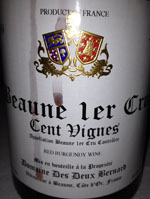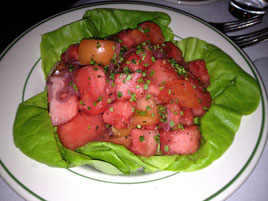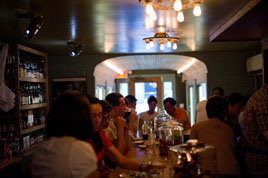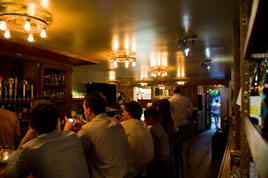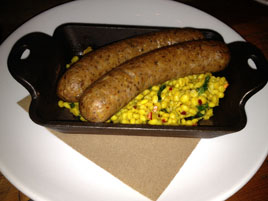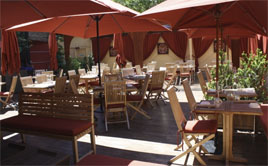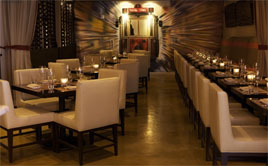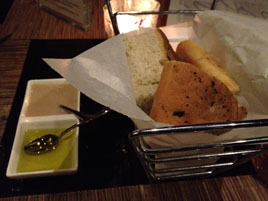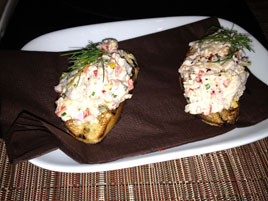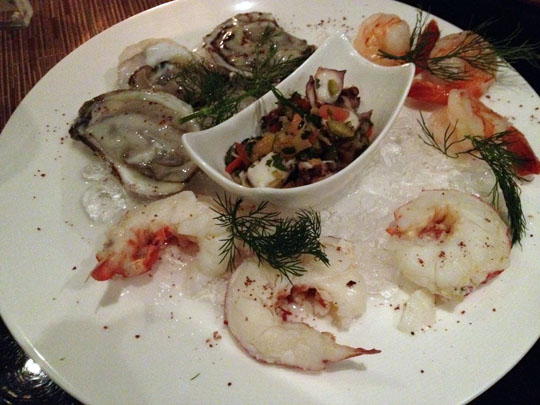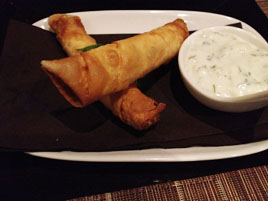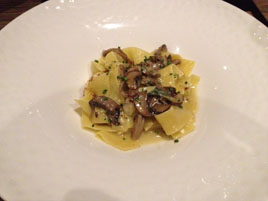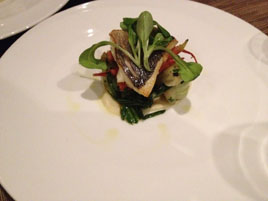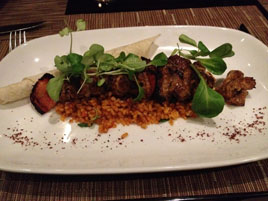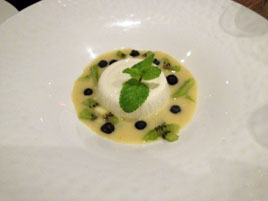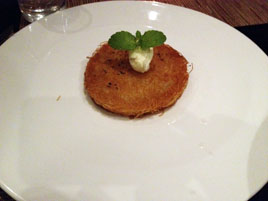Aska
 Monday, December 17, 2012 at 09:22PM
Monday, December 17, 2012 at 09:22PM 
Note: Aska at Kinfolk Studios closed in early 2014. The restaurant re-opened in 2016 in a new location, still in Williamsburg. The new Aska has more space and more sensible hours, as it is no longer the subtenant of a gallery. The meal reviewed below was at the former location.
*
 Earlier this year, the Modern Nordic restaurant sensation Frej (pronounced Fray) flew past New York like a comet. Open for just six months, it was a critical darling and food board sensation.
Earlier this year, the Modern Nordic restaurant sensation Frej (pronounced Fray) flew past New York like a comet. Open for just six months, it was a critical darling and food board sensation.
But what was it, exactly? A real restaurant, or just a pop-up? It served a $45 five-course tasting menu just three nights a week, Mondays through Wednesdays, in what seemed to be a makeshift space. (It was a noodle shop and a party space the other nights of the week, and a design studio by day.)
Reservations were taken only by email, a system as inefficient as it was disorganized. It took about a dozen messages, back and forth, over a month or more, for me to get a booking. Then Frej closed abruptly for a month of “renovations.” No one bothered to tell me my reservation wouldn’t be honored (though, fortunately, I was well aware of it anyway).
 In New York, “closed for renovations” often means “closed for good,” and that was the case here. A month morphed into nearly four, before the space re-opened as Aska. The part-time ramen shop is gone. The tasting menu (now $65 for ten incredible courses) is now served five nights a week (Sunday to Thursday). The bar, with a short à la carte menu, is open seven days a week. It’s still in the Kinfolk Design Studio, doubling as a coffee shop by day. Reservations are taken online—a far more civilized way of handling it.
In New York, “closed for renovations” often means “closed for good,” and that was the case here. A month morphed into nearly four, before the space re-opened as Aska. The part-time ramen shop is gone. The tasting menu (now $65 for ten incredible courses) is now served five nights a week (Sunday to Thursday). The bar, with a short à la carte menu, is open seven days a week. It’s still in the Kinfolk Design Studio, doubling as a coffee shop by day. Reservations are taken online—a far more civilized way of handling it.
Fredrik Berselius, one of the two original Frej chefs, runs the kitchen. (The other, Richard Kuo, is now at Pearl & Ash on the Bowery.) Joining Berselius is GM and cocktail/wine guru Eamon Rockey, formerly of Eleven Madison Park, Compose, and Atera.
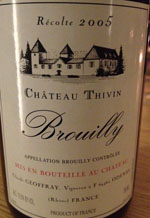 The deep, narrow space looks similar to the photos I’ve seen of Frej. Some of the artwork has been removed, making it feel even more austere than before. Housed in the back of a renovated garage, there are just seven tables, seating a mere 18 guests. There’s an partly-open kitchen, a bar, and in the front a cocktail lounge.
The deep, narrow space looks similar to the photos I’ve seen of Frej. Some of the artwork has been removed, making it feel even more austere than before. Housed in the back of a renovated garage, there are just seven tables, seating a mere 18 guests. There’s an partly-open kitchen, a bar, and in the front a cocktail lounge.
I don’t know if the heating system is unreliable, but when the hostess seated us, she offered blankets, should we need them. We did not come anywhere close to taking her up on it.
The staff paces the reservations book at leisurely intervals. Just our table was seated at 6:00 pm on a Sunday; then the second at 6:30, the third at 7:00, the fourth at 7:15, the fifth at 8:15, the sixth and seventh at 8:30. This is obviously a deliberate strategy, as when I reserved, only the 6:00 and 7:00 times were available.
Serious Eats had a preview of the cocktail program: “No one could ever accuse Eamon Rockey…of not being a patient man. Of the eight signature cocktails he’s created for the just-opened modern Scandinavian concept, not one is without an ingredient that requires some sort of time-consuming infusion, fermentation, or extraction process.”
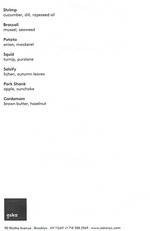 I tried two excellent examples: the US Export (“whiskies of all sorts, pear, maple, angostura”) and the Next of Kin (“aquavit, pu-erh combucha, caraway”), both excellent, and at $12 well below the going rate. Full disclosure: Rockey recogonized me, and the cocktails were comped.
I tried two excellent examples: the US Export (“whiskies of all sorts, pear, maple, angostura”) and the Next of Kin (“aquavit, pu-erh combucha, caraway”), both excellent, and at $12 well below the going rate. Full disclosure: Rockey recogonized me, and the cocktails were comped.
(There’s a photo of the cocktail and beer list near the top of this post; click on the image for a larger view.)
There’s an international wine list that runs to two pages, with separate sections dedicated to Riseling and Beaujolais, both of which Rockey feels pair particularly well with the food. We took his advice, ordering a 2005 Beaujolais.
The food is in the same austere, Modern Nordic style as the décor. The staff handed us a menu at the end of the meal, wrapped up as if it were a parchment scroll. (Click on the photo, above left.) However, that menu lists just seven courses. Counting various amuses, it was more like ten, or eleven if you count the bread.
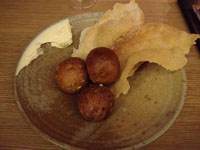 Most dishes come with fairly elaborate descriptions from the server. If “pork chop, carrots, and mashed potatoes” is as much of an explanation as you want, Aska is not the place for you. Platings are elaborate, each its own modern art sculpture. Some of them are gone after just a bite or two. A hearty eater might still be hungry afterward—though we weren’t.
Most dishes come with fairly elaborate descriptions from the server. If “pork chop, carrots, and mashed potatoes” is as much of an explanation as you want, Aska is not the place for you. Platings are elaborate, each its own modern art sculpture. Some of them are gone after just a bite or two. A hearty eater might still be hungry afterward—though we weren’t.
The chef can write a symphony with root vegetables. But at $65, some compromises are inevitable. You won’t find caviar, Wagyu beef, foie gras, lobster, white truffles, or other luxury ingredients. The protein courses are the menu’s weak spot. If Aska is a hit (and after less than a month in business, it’s well on its way), look for the price to go up, along with the quality of the ingredients.
The bread service (above right) consisted of warm, sweet caraway rolls and salty, crisp flatbread (like a thin pretzel), with a splash of soft butter hugging the upper left edge of the bowl.


The first amuse (above left) was a chip of crispy pike skin with sour cream, and a disc of shortbread with cheese and juniper. The second (above right) was an inner tube-shaped helping of pig skin with jam (6:00 position), a chip of dehydrated pig’s blood (2:00), and a buckthorn.
(Despite the “ick” factor, the pig’s blood chip did not taste like blood at all.)
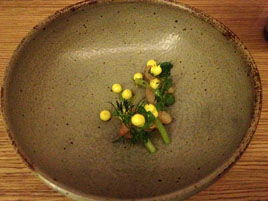
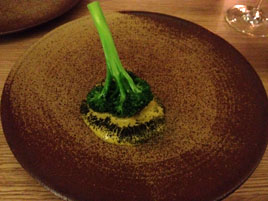
We moved onto the first of the courses listed in the printed menu, smoked and dried shrimp (above left) with cucumber and rapeseed oil, which had a rich, salty flavor. A warm stalk of broccoli (above right) stood straight up, resting in a bath of mussel emulsion and seaweed dust. The note I took at the time, was: “Wow!”
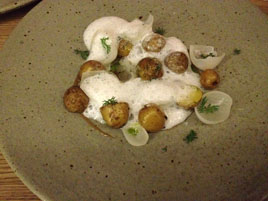

A course described as “Potato” (above left) was something more elaborate, a stew of potato, onion, and mackerel, with a warm milk foam poured by the chef at tableside. To go with it, the owner poured a glass of potent milk punch made with aquavit.
Squid (above right) with purslane and turnips was our first dud: rubbery, bitter, and flavorless.

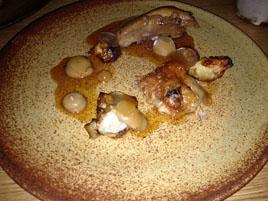
We adored the Salsify (above left), with celery root, wild greens, and lichens. “This is too good to be just vegetables,” my girlfriend said.
But Pork Shank (above right) with sunchokes was another dud, a one-note dish not rescued by a helping of apple cider poured tableside.
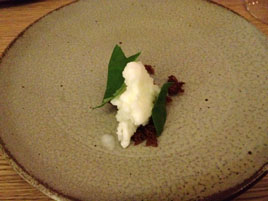
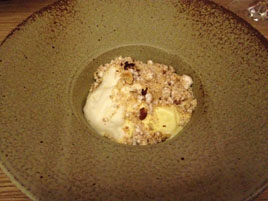
The palate cleanser (not listed on the printed menu) was a half-scoop of Whey Sorbet (above left) with oak chip and French sorrel. Dessert (above right) was an excellent cardamom ice cream with brown butter mousse and hazelnuts.
The service was as good as at any three-star restaurant. With four servers for seven tables, nothing went unnoticed. Clean plates and empty glasses were noticed almost instantly.
Aska is just three weeks old, so there are no professional reviews yet, but the basic idea is similar to Frej, which was a big hit. This is surely the best $65 meal in town, but I’ll bet it hits $95 within two years. If Fredrik Berselius can keep cooking like this, it’ll be well worth it.
Aska (90 Wythe Avenue at N. 11th Street, Williamsburg, Brooklyn)
Food: Austere Modern Nordic, most of it stunning and flavorful
Service: As attentive and helpful as at any three-star restaurant
Ambiance: A renovated garage, comfortable but as austere as the food
Rating: ★★★
Why? There is nothing else like this in New York. By all means go.
 Aska in
Aska in  Brooklyn,
Brooklyn,  Cuisines: Scandinavian,
Cuisines: Scandinavian,  Restaurant Reviews
Restaurant Reviews 


